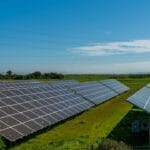Key Takeaways
- Solar energy systems convert sunlight into electrical energy, offering a sustainable power source.
- Key components include solar panels, inverters, disconnects, racking, charge controllers, power meters, and batteries.
- Understanding the role of each component is crucial for efficient installation and operation.
- There are different types of solar panels and inverters to consider based on your needs.
- Safety devices like disconnects are essential for maintenance and emergency shut-off.
Introduction to Solar Power
Imagine harnessing the sun’s energy to power your home. It’s not just a dream; it’s a reality made possible by solar power systems. These systems are a beacon of sustainability, shining a light on how we can reduce our carbon footprint and save on energy costs. But what does it take to capture a ray of sunshine and turn it into electricity? Let’s dive in.
Brief history and evolution of solar technology.
Solar technology isn’t new. In fact, it dates back to the 1800s when scientists first discovered that sunlight could generate electricity in certain materials. But it wasn’t until the 1950s that the first practical solar cells were developed. Since then, advancements have been made leaps and bounds, making solar power more efficient, affordable, and accessible than ever before.
Importance of solar energy in today’s world.
Why go solar? Because it’s clean, renewable, and abundant. Unlike fossil fuels, solar energy doesn’t release harmful pollutants into the air. And there’s enough sunlight hitting the Earth every hour to meet the world’s energy needs for an entire year! It’s no wonder more and more homeowners are looking up to the sun for their power needs.
The Beauty of Solar Systems
Solar systems are like a symphony, where each component plays a critical role in producing harmonious energy. They capture sunlight and convert it into a form we can use to light up our homes, charge our devices, and even heat our water. It’s the magic of technology meeting nature.
Overview of how solar systems convert sunlight into electrical energy.
Here’s how it works: Solar panels absorb sunlight, which contains energy particles called photons. These photons then knock electrons loose in the panel’s cells, creating a flow of electricity. This is known as the photovoltaic effect, and it’s the cornerstone of solar power technology.
The significance of each component in the solar system.
Each component in a solar power system has a specific function. The panels collect the sun’s energy, the inverter converts that energy into a form we can use in our homes, and other components like the racking system and disconnects ensure the system is secure and can be maintained safely. It’s a well-orchestrated process that makes solar power possible.
Component 1: Solar Panels
Solar panels are the most visible part of a solar power system. They’re the ones that capture the sun’s rays and start the energy conversion process. But not all solar panels are created equal. There are several types to choose from, each with its own advantages.
Types of Solar Panels: Monocrystalline vs. Polycrystalline vs. Thin-Film
Monocrystalline panels are known for their high efficiency and sleek look. They’re made from single-crystal silicon, making them more efficient at converting sunlight into electricity. Polycrystalline panels, on the other hand, are made from multiple silicon crystals and are typically less expensive but also slightly less efficient. Thin-film panels are the most lightweight and flexible, but they generally have the lowest efficiency. Your choice will depend on your budget, space, and energy needs.
Proper Panel Placement and Angling for Maximum Efficiency
Placing your solar panels is not just about finding a sunny spot. It’s about maximizing exposure to the sun’s path. That means considering the angle of your roof, any nearby shade, and even the latitude of your location. The goal is to have your panels face south in the Northern Hemisphere and north in the Southern Hemisphere, tilted at an angle that equals your latitude for peak efficiency. And don’t forget, a little bit of math now can lead to a lot of saved energy later.
Component 2: Solar Power System Disconnects
Let’s talk safety. Disconnects may not be the most glamorous part of a solar power system, but they’re vital. They allow you to cut off the flow of electricity from your solar panels, which is crucial during maintenance or emergencies. Think of them as the off switch for your solar power.
The Role of Disconnects in Safety and Maintenance
Disconnects are installed both on the DC side, between the solar panels and the inverter, and on the AC side, between the inverter and your home’s electrical panel. This dual placement ensures that you can safely shut down your system to prevent electrical shocks or damage during maintenance or in the event of a fault.
Types of Disconnects: AC vs. DC
There are two main types of disconnects: AC and DC. AC disconnects are used to isolate the inverter from the grid, and DC disconnects are used to isolate the solar panels from the inverter. The type you need will depend on the configuration of your solar power system, but both serve the essential function of keeping you and your system safe.
Component 3: Solar Inverter
Now, let’s shift our focus to the inverter, a pivotal component of your solar system. The inverter is like a translator, taking the DC (Direct Current) electricity generated by your solar panels and converting it into AC (Alternating Current) electricity, which is what powers everything in your home. Without an inverter, the energy captured by your panels would be as useless as a screen door on a submarine.
Here’s the deal: your solar panels work hard to capture sunlight and convert it into DC electricity. But our homes and the electrical grid operate on AC electricity. That’s where the inverter comes in, flipping the script (or current, to be more accurate) so that the power can be used or sold back to the grid.
Converting DC to AC: How Inverters Work
Inside every inverter is a complex electronic system that uses semiconductors to switch the DC input from the panels in a very rapid on-off pattern, creating an AC waveform. This waveform is synchronized with the grid’s frequency so that it can be fed into your home’s electrical system or back into the power grid.
But not all inverters are the same. There are a few different types of solar inverters, each with their own benefits and best use cases. Choosing the right one is key to getting the most out of your solar investment.
Most importantly, the inverter’s capacity must match your solar array’s output. If it’s too small, you’ll lose some of the power your panels produce. Too large, and you’ve spent more than you needed to. It’s like choosing a backpack for a hike; you want one that’s just the right size for your gear.
String Inverters vs. Microinverters vs. Hybrid Inverters: Which is Right for You?
String inverters are the most common type. They connect to a ‘string’ of solar panels, converting the combined DC output to AC. If your system is straightforward and you don’t have shading issues, a string inverter could be a great, cost-effective choice.
Microinverters, on the other hand, are installed on each solar panel. They’re perfect for roofs with shading or different orientations because they optimize each panel individually. Think of it like having a personal trainer for each solar panel, ensuring it performs its best.
Hybrid inverters combine the functions of a string inverter with a battery charger. They’re ideal if you’re considering adding battery storage to your system down the line. It’s like buying a phone with extra storage space – you might not need it now, but it’s nice to have the option for the future.
Component 4: Solar Racking
The unsung hero of any solar installation is the racking system. It’s the foundation that holds your solar panels in place, come rain or shine. Choosing the right solar racking system is crucial because it affects not only the durability and longevity of your solar installation but also its performance.
Solar racking needs to withstand the elements while keeping your panels angled correctly for optimal sun exposure. It’s like the frame of a painting – it has to be sturdy and enhance the beauty (or in this case, the efficiency) of what it holds.
Installation is key here. Poorly installed racking can lead to roof damage, reduced energy output, and even safety hazards. Therefore, it’s essential to work with professionals who understand the nuances of your particular roof type and local weather conditions.
Choosing the Right Solar Racking for Your Roof Type
There are different racking systems for different roof types. If you have a standard asphalt shingle roof, there are racking systems designed to be installed with minimal disruption to the roofing material. For tile roofs, there are systems that can replace a tile to sit flush and maintain the aesthetic of your home.
Ground-Mount vs. Roof-Mount Systems: Comparing the Options
But what if your roof isn’t ideal for solar? No worries, you can still soak up the sun with a ground-mount system. These are great for people with plenty of yard space and a less-than-perfect roof situation. They can be placed at the perfect angle and orientation without the constraints of roof design. On the flip side, roof-mount systems save space and are generally more protected from accidental damage. It’s like choosing between a garden bed and a hanging planter – both grow flowers, but the setup is different.
Component 5: Charger Controllers
For those who want to store the sun’s power for a rainy day, you’ll need a battery system, and with it, a charge controller. This little device regulates the flow of energy to and from your batteries, ensuring they don’t overcharge during the day or drain too much overnight.
Maximizing Battery Life: The Function of Charger Controllers
Charge controllers are the guardians of your battery’s lifespan. They protect your batteries from the two big no-nos: overcharging and deep discharging. Both can significantly shorten a battery’s life, which is why a charge controller is not just helpful, it’s essential.
Think of a charge controller like a traffic cop for your solar system’s energy. It directs the flow of electricity at the right speed, making sure your batteries charge safely and efficiently. Without it, you’d have the solar equivalent of a traffic jam – energy going everywhere, with nowhere good to go.
PWM vs. MPPT Charger Controllers: Understanding the Differences
There are two main types of charge controllers: PWM (Pulse Width Modulation) and MPPT (Maximum Power Point Tracking). PWM controllers are more basic and cost-effective, suitable for smaller systems or where panel and battery voltages are the same. They’re like the on-off switch of charge controllers – simple but effective.
MPPT controllers are more advanced, optimizing the power from your panels to charge your batteries. They can handle a variety of voltages and are more efficient, especially in colder climates or when the sun’s not at its strongest. It’s like having a smart thermostat for your solar system – it adjusts to get the most out of your panels, no matter the weather.
Component 6: Solar Power Meter
Lastly, let’s not forget about the solar power meter. This handy device measures the amount of electricity your solar system produces and sends to the grid. It’s essential for anyone looking to get credit for their surplus energy through net metering.
With a solar power meter, you can literally watch the savings roll in. It’s a great motivator to see the impact of your solar investment in real-time. Plus, it provides valuable data to help you understand your energy usage patterns and optimize your consumption.
Net metering allows you to earn credits for the excess electricity your solar system produces, which can offset the cost of power drawn from the grid at night or on cloudy days. It’s like banking sunlight – save it up during the day, and cash it in when you need it.
Monitoring your solar system’s output is more than just satisfying; it’s empowering. By understanding what you’re producing, you can make informed decisions about your energy use and truly harness the power of the sun.
Net Metering Explained: How to Get Credit for Excess Energy
Net metering is a billing mechanism that credits solar energy system owners for the electricity they add to the grid. For example, if a residential customer has a solar PV system on their home’s rooftop, it may generate more electricity than the home uses during daylight hours. If the home is net-metered, the electricity meter will run backwards to provide a credit against what electricity is consumed at night or other periods where the home’s electricity use exceeds the system’s output. Customers are only billed for their “net” energy use.
It’s like rolling over minutes on a cell phone plan. The more you produce, the more you can offset later use. This arrangement makes solar power even more attractive for homeowners, as it can significantly reduce the electric bill.
Component 7: Solar Battery Storage Unit
When the sun sets, your solar panels go to sleep. But with a solar battery storage unit, you can keep the lights on using the energy your system generated during the day. This is especially useful in off-grid systems or during power outages.
Battery storage systems are like reservoirs – they store excess power when the demand is low and release it when the demand is high, ensuring a consistent energy supply regardless of sunlight availability.
Choosing the right battery for your system is crucial. You need to consider capacity, lifespan, and cost to make sure it meets your needs.
The Importance of Batteries in Off-Grid Solar Systems
In off-grid solar systems, batteries are the backbone. They store the power generated by your panels for use when the sun isn’t shining. Without batteries, an off-grid system simply wouldn’t function.
Batteries also provide stability to the system, smoothing out the supply and ensuring that power is available when it’s needed most. This makes them essential for anyone living in an area without reliable access to the grid.
Types of Solar Batteries: Lead-Acid vs. Lithium-Ion
Lead-acid batteries have been used for decades and are known for their reliability and low cost. They’re like the workhorse of solar batteries – not the most efficient, but they get the job done.
Lithium-ion batteries are the newer kids on the block. They’re smaller, lighter, and have a higher energy density, which means they can store more electricity in a smaller space. They’re like the sports car of batteries – fast, efficient, and a bit more expensive.
Frequently Asked Questions (FAQ)
With any new technology, questions abound. Let’s clear up some of the most common queries about solar power systems.
How Long Do Solar Panels Typically Last?
Solar panels are surprisingly hardy. Most come with a warranty of 25 years, but they can last much longer than that. In fact, there are panels installed in the 1980s that are still generating power today. So, while your panels will gradually produce less power over time, they’ll likely be a part of your home for decades to come.
What Size Inverter Do I Need for My Solar System?
The size of your inverter should match the peak load of your solar panel system. In general, you’ll want an inverter that can handle about 10-20% more than your system’s maximum output to ensure it’s not constantly running at full capacity, which can shorten its lifespan.
For instance, if your solar panels can produce a maximum of 5kW of power, you’ll want an inverter that can handle at least 5.5kW to 6kW.
Are Solar Power Systems Weatherproof?
Yes, solar power systems are designed to withstand the elements, including rain, wind, and even hail. The panels themselves are encased in tempered glass and framed in metal, making them quite durable. However, it’s important to have them installed by a professional to ensure they’re properly secured and that your roof can support them.
Is it Possible to Install a Solar Power System Myself?
While it’s technically possible to install a solar power system on your own, it’s not recommended unless you have professional training. There are many factors to consider, from the electrical work to the physical installation of the panels. A professional installer can ensure everything is set up safely and efficiently.
Can Solar Power Systems Work at Night or During Cloudy Days?
Solar panels need sunlight to generate power, so they won’t work at night. However, if you have a battery storage system, you can use the energy stored during the day to power your home at night. On cloudy days, your system will still produce electricity, just not as much as on a sunny day. It’s all about capturing and storing that sunlight when it’s available.















